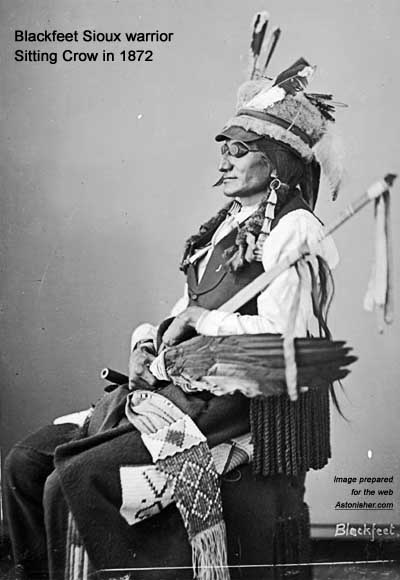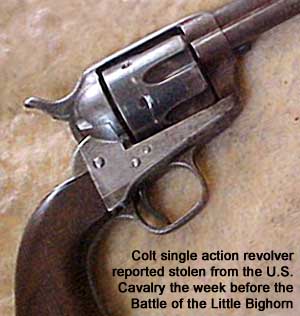|
||||||||||||
Bruce Brown's 100 Voices... Foolish Elk's Story of the Battle
He said he was in the fight against Crook on the Rosebud about a week before the Custer battle. Before the battle of the Rosebud started, they were in doubt as to the intentions of the soldiers, not knowing whether they wished to fight or make a treaty. The Indians therefore got all ready to fight and waited to see what the soldiers would do. As the soldiers started the firing, the Indians concluded that they desired to fight, and so they gave them what they appeared to want. In this fight the Indians thought they had won a victory, but it was understood that other troops were in the Indian country, and they concluded to go to the big village with Sitting Bull on the Greasy Grass Creek (Little Bighorn) without further loss of men and ammunition. They therefore withdrew and went over the divide to the Little Bighorn. He could not describe the exact route traveled, but did not think Custer's command could have followed any part of their trail except for a few miles before striking the village. They arrived at the village the day before the battle (June 24). There was then some kind of vague report that soldiers were coming, but they did not know whether it was the command of their recent enemy, Crook (Lone Star), or Custer whom they knew as "Long Yellow Hair." In the village there were representatives of seven tribes of the Sioux.2 There was not much concern about the soldiers, as the Indians thought they had enough men to whip any force that would come against them, seeing that the Indians were all together for once - all the different tribes. On June 25 the fighting started at the Uncapapa tepees (by Reno at south end of village). On the part of the Indians there was no organized resistance, but men from all the tribes who happened to have their horses grabbed up their guns and went up the river to join in the fight. The fight did not last long, and before the larger part of the Indians could get there, they had chased the soldiers out of the river valley and up into the bluffs. The soldiers retreated across the river at the nearest point they could reach and seemed to be in too much of a hurry to take their back track to the ford where they had come into the valley. Before the Indians had decided what they would do with these soldiers who made the first attack, a force of soldiers was seen coming from the east (Custer). These men sat on their horses and fired across the river into the village, without getting into it. He afterward heard that one man3 rode his horse over into the village and was killed, but he did not see him. [Note: here are White Shield, White Cow Bull and Peter Thompson's descriptions of Custer's ride to the river after Reno had already attacked the Indian village.] The Indians were now getting their horses in from the hills and soon came up in large numbers. Some crossed the stream farther down and others crossed the ford and followed on after Custer in overwhelming numbers. They could not see how such a small force of soldiers had any chance to stand against them. The Indians were between Custer and the river and all the time coming up and getting around to the east of him, passing around both his front and rear. Custer was following the ridges, and the Indians were keeping abreast of him in the hollows and ravines. Personally, he was with the Indians to the east, or on Custer's right. Custer charged the Indians twice (probably at Calhoun and at monument4 or in gully toward river from monument) but could not drive them away, and then the battle became furious. It did not appear to him that a stand was made by Custer's men anywhere except at the monument. He was in the gully and saw the soldiers killed on the side hill (Keogh) as they "marched" toward the high ground at end of ridge (monument). They made no stand here, but all were going toward the high ground at end of ridge. The gray horses went up in a body; then came bay horses and men on foot all mixed together. The men on the horses did not stop to fight, but went ahead as fast as they could go. The men on foot, however, were shooting as they passed along. When the horses got to the top of the ridge the gray ones and bays became mingled, and the soldiers with them were all in confusion. The Indians were so numerous that the soldiers could not go any further, and they knew that they had to die.
The Indians captured many horses that were not wounded, and they got much ammunition out of the saddles and out of the belts of the killed and wounded. Many squaws followed the course of the battle and stripped the dead. He did not remain to see any of the wounded soldiers killed, but thought most of them must have been killed before the general firing stopped. He did not know whether or not any of the dead soldiers were scalped. No soldiers, dead or alive, were taken into the village. He wanted to know why I inquired on this point. I told him that it might be supposed that some of the soldiers were taken alive and tortured. He then laughed and said that had I seen the amount of firing that was done on the battlefield I would never suppose that any of the soldiers could come out alive. I then asked him how he could account for some 18 bodies that could not be found. He said he could give no explanation, but felt sure that all would have been found had those in search of them looked far enough. On the day of the battle no Indian recognized Custer, either alive or dead. They had remembered him as a man with long hair, but his hair was cut. On the next day one of the Uncapapa men who knew him recognized him from his features, and later his horse was recognized among the captured animals. This was the sorrel horse "Dandy" with white face and white feet. Walter Camp's Notes: NOTES 1. Walter Camp field notes, folder 106, BYU Library. 2. The tribes of the Siouan Teton family were the Hunkpapa, Brule, Sans Arc, Minneconjou, Blackfeet, Ogalalla, and Two Kettles. 3. Sergeant James Bustard of Company I may have been this man. 4. Lieutenant James Calhoun commanded Company L in the fight and held the southeast end of Custer ridge. The monument mentioned is the present monument at the northwest end of Custer ridge. 5. This may have been Lieutenant Henry M. Harrington of Company C. Custer in '76: Walter Camp's Notes on the Custer Fight, edited by Kenneth Hammer, Brigham Young University Press 1976 p 197 - 200
There were two warriors named Foolish Elk at the Battle of the Little Bighorn, one a Brule and the other an Oglala.
|
||||||||||||




 FOOLISH ELK SAID he was an Ogalalla Sioux 54 years old, and on the day of the Custer battle fought with
FOOLISH ELK SAID he was an Ogalalla Sioux 54 years old, and on the day of the Custer battle fought with 








